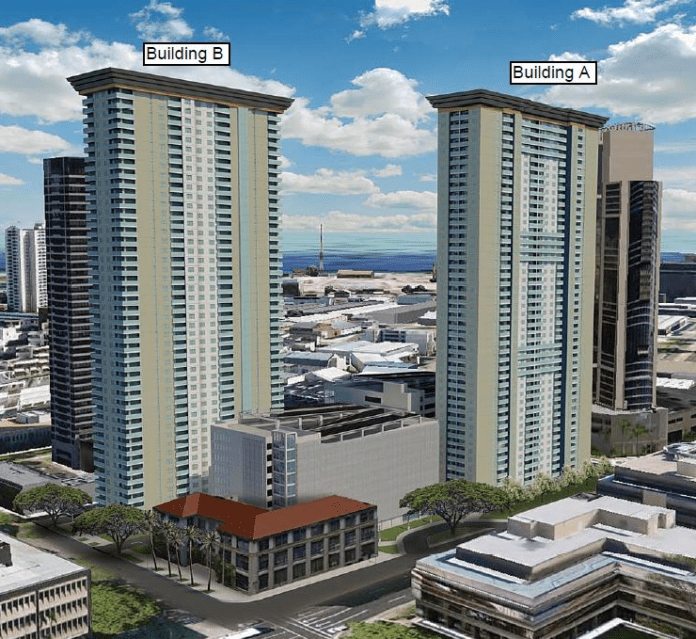 By Ariel Salinas – A Star Advertiser Op Ed of December 4 by 801 South St. developer Marshall Hung proclaims that his proposed monolith “will bring new vitality to Kaka’ako.”
By Ariel Salinas – A Star Advertiser Op Ed of December 4 by 801 South St. developer Marshall Hung proclaims that his proposed monolith “will bring new vitality to Kaka’ako.”
That remains to be seen.
He states that his “workforce housing project” falls into a different category of affordable housing. We’d have to agree with that statement if we are talking about affordable for the very rich, because if you have enough money you can afford anything. Calling his project “affordable” for the workforce, however, challenges credulity and is akin to Orwellian “doublespeak” which serves to distort and obfuscate reality.
Let’s start with prices. According to the Hawaii Community Development Authority (HCDA), the maximum affordable sales price for this development is $655,000 for a one bedroom unit and $715,000. The developer can sell units at these amounts and still meet the “workforce housing” affordability criteria.
Hung claims that these units, which in theory are to be set aside for essential workers such as policemen, firemen, and teachers, meet the HCDA’s “affordability” criteria when priced at these astronomic levels. Let the cognitive dissonance commence.
Does Hung really believe that secretaries, police officers, or essential workers can really afford a two bedroom unit in the $700,000s?
The developer has to balance the need to make a profit while providing units that may necessarily be discounted below market values. However, it’s disingenuous at best and fraudulent at worst to pitch 801 South Street Tower B as some kind of worker’s paradise housing complex. Even a family of four, earning an annual income of $120,000 (the maximum allowed under the law to purchase “workforce housing”) could not afford any of the two bedroom units in 801 South Tower B.

So how did Hung and the HCDA arrive at such inflated affordability critera? I have reverse engineered the HCDA’s math and have found numerous errors, omissions and extraordinarily generous assumptions that have enabled Hung and the HCDA to claim the obviously un-affordable as affordable. Here are some of the highlights:
· HCDA assumes a 2.9% interest rate for a 10% down 30-yr fixed loan, while local banks are qualifying the long locks required for 801 South Street at 5.5%. Why the disparity? Banks, which anticipate rising interest rates, need to lock rates in now for a loan to be taken out in 2016, at building occupancy. Accurate affordability calculations need to account for the actual interest rate available, and 2.9% is nearly half of the actual figure.
· Astonishingly low interest rates are accompanied by monthly association dues of only $305 for 2 bedroom units and $250 for 1 bedroom apartments. The claimed two bedroom dues are less than half of the lowest comparable building in the area. In their permit application, the developr provides incorrect data to justify these unbelievably low dues. Caveat emptor.
· Homeowners insurance costs are not part of the equation, even though the law specifically requires this to be included in the affordability calculations. Any bank can tell you that no homeowners insurance equals no loan.
· The household sizes that the developer uses to justify affordability calculations are double the current average household size in Kaka’ako. Why does this little detail matter? The cost equation takes into account household sizes, with larger sizes allowed a larger scaling factor per U.S. HUD guidelines. Overestimating the household size allows the HCDA to further inflate affordability numbers.
· There is no allowance made for the substantial down payments that will be needed for the loan. Given how high the maximum affordable sales prices have been calculated, the required down payments would be beyond the means of the typical household.
If the real workforce can’t afford this housing, who can?

One would think the developer and HCDA would be pleased to provide a buyer profile of all the families who have been recipients of workforce housing in Tower A of the 801 South St project. After all, the justification to destroy more than half of the historic Advertiser building (with a double high Tower B and 11-story parking structure) is to create reasonably priced housing.
If you ask the HCDA or developer for the buyer profile, no one seems to have an answer.
If the developer is to benefit by being granted variances under the pretense of building workforce housing, there should be an accounting for how well this has worked in the past. Where is the proof that these units are actually being sold to qualified buyers under the program?Before approving this project at the very least there should be an audit to ascertain who is really buying the units set aside for workforce housing.
This begs the question of whether the HCDA is indeed capable of objectively balancing and managing the development of Kaka’ako with the greater good of the community. With a Governor-appointed board consisting of building industry executives, who is looking out for the average citizen?
In its present composition, the board is biased towards big developers and industry interests. There is inadequate representation from the general community.With two vacant seats available, there is now an opportunity to choose from any number of interested and highly qualified community members who could participate meaningfully in the process and bring balance back to HCDA’s decision making process.
Marshall Hung is correct.
We need affordable housing in Kaka’ako.
Ariel Salinas is a civil engineer and member of Kaka’ako Cares a citizens group advocating smart development in Kaka’ako. Salina resides with this wife and two children in Kaka’ako. Go to https://goo.gl/8qsR0o to read his detailed Affordability Analysis on the subject.

